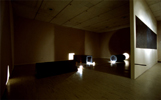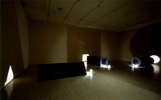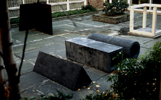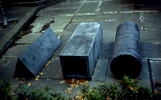

Consists of three black and white photographs, three color photographs, text from Plato's "Myth of the Cave" , three black wall paintings and three black concrete castings.
"Plato's Perfection Inversed" (1976-78) wherein the philosopher's basic premise was questioned in this conceptual installation was first organized by Alanna Heisse at P. S. 1 Contemporary Art Center, Long Island City, Queens as a part of the "Rooms" series. Later, it was shown at The Dartmouth College Museum, currated by Jan van der Marck where the three castings remain on permanent display in the sculpture garden:
"Plato's Simile of the Cave" stated that truth is but a shadow cast by a flickering fire, while "Plato's Perfection Inversed", states that only through shadows may we perceive the truth... Perception is aleatory, subjective, and conditioned by experience… Hondrogen’s work trades on it. His concerns as an artist address form, surface, and image…
The artist reminds us that indeed there is a difference between the physical object, the way the eye perceives it, and our mind’s superior knowledge of it. His art deals with how reality is projected, how we become aware of the formal structure of things and thus gain an insight into reality’s nature and functioning. Order is inferred from chaos and purpose from happenstance.
Hondrogen helps us put reality into a new mental perspective. He inverts the common understanding of Plato’s simile of prisoners chained inside a cave and perceiving reality as but shadows of the truth... He keenly senses the relative character of truth, the multiplicity of meaning, the ambiguity of perception and the treachery of time...
Form, to Hondrogen, is an embodiment of fiction made to look like the truth.”
Jan van der Marck, Museum Director. Page 7. Nicholas Hondrogen 1968-1979. Dartmouth College Museum. 1979. 42 pages. Softcover.

